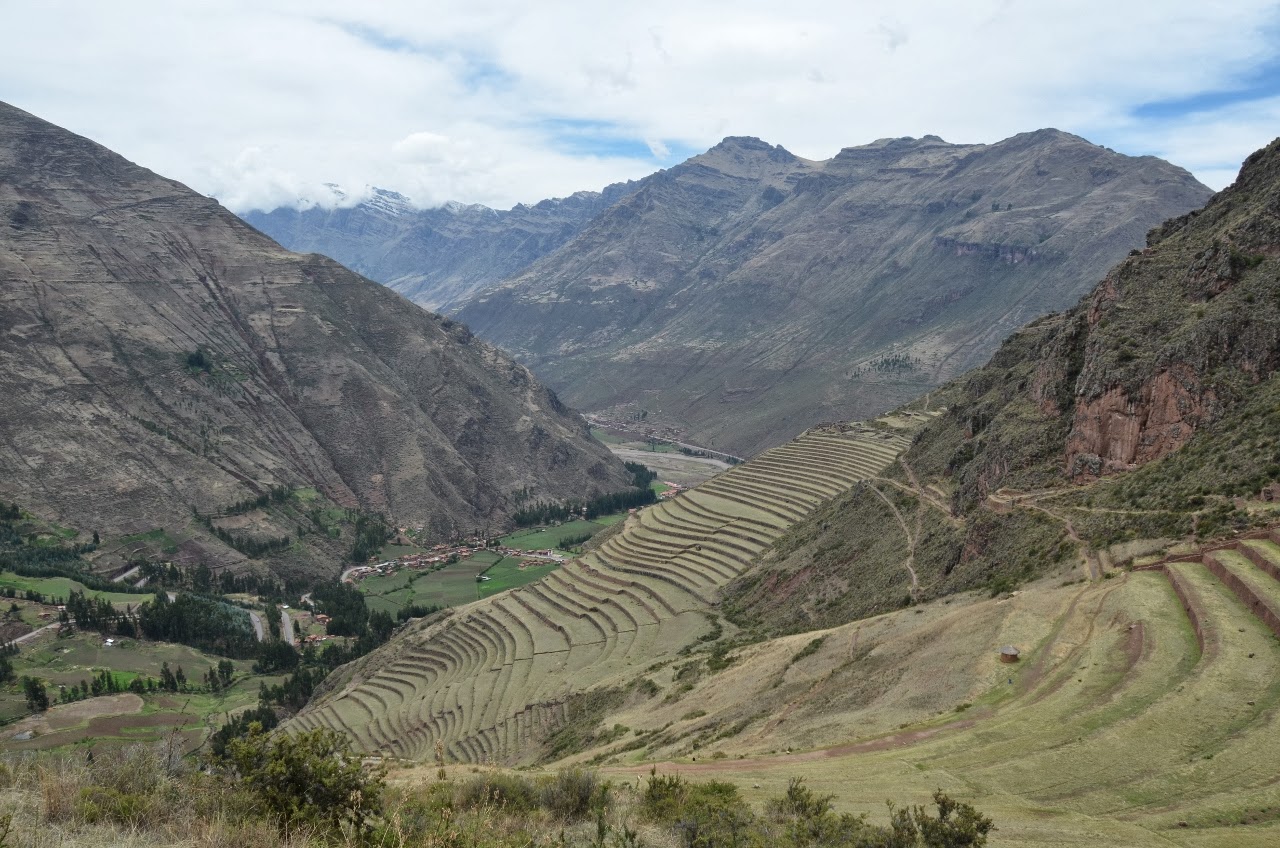Getting High in Peru: Pisac, on the Road
to Machu Picchu
 |
| This is a Google Earth picture of the site with terracing |
 |
| I'm zooming in with Google Earth. The site is to the top of the terracing |
|
Above, the roads to the site are to the right of the terraces.
Below, just north of the center is where we gather to climb up to the ruins
 |
| The students will be climbing all over the top of the site. |
 |
| Approaching the parking area but you can see the terracing as on the Google maps. |
 |
| Access path to the terraces and the site. |
Pisac
is approximately 20 miles (32K) NE of Cusco where the Sacred Valley begins and
is worth a visit. I’m not just referring to the current village with its market
(Mercado), which has taken over the Plaza de Armas, but before you arrive in
the village, you see spectacular agricultural terraces with channels to carry
water and you see countless steps cut from mountain’s rock used to ascend and
descend the terraces. Pisac is a pre-Inca site. The construction of some of the
walls gives this away, but when the Incas took over, they did not destroy, but
instead maintained and expanded Pisac. The Incas did develop a unique style of
building walls, and they did improve on terrace building creating a
micro-climate improving agricultural harvest. The rape and destruction of the
various sites in Peru happened when the Spanish arrived.
 |
| On site |
 |
| Note the surrounding white capped mountains |
 |
| The snowy mountains and village below |
 |
| This access path is clearly visible on Google maps |
As
you look at the mountains surrounding Pisac, you will see snowy peaks that were
important for the ancient peoples including the Inca. To raise crops in these
higher elevations, you had to consider room to plant crops, the amount of water
and sun light needed. Evidently, the ancient peoples considered the possibility
of excessive wind and hail in constructing the terraces and also considered the
amount of sun the terraces would receive. In addition, the Inca developed a
variety of crops that grew well at different elevations. Long before today’s
Monsanto, the Incas developed genetics for crops and in this valley had 17
varieties of corn for the various elevations and amounts of sun light.
 |
| Guide Explanation |
 |
| Note that the two tall students are yawning--perhaps to clear the ears due to the elevation |
One
of these surrounding terraced mountains was given the name “Condor Mountain” since
terraces cut from the mountain side form the shape of a condor. An adult condor
can have a wingspread of ten feet and is a scavenger. It is God’s cleanup bird
and the pre-Inca and the Inca associated the condor as the guardian spirit of
the dead which would carry you on its wings to the world beyond this one.
Watching them soar through the Andean air is a treat and it is easy to picture myself
(or wishing) to be able to soar on the wings of a condor and not grow weary (Isaiah
40: 31)*. I could not see the condor on the mountainside but hope to look again
next time. Once we arrived at the archaeological site though, we were at the
wrong angle to see the “condor.” The terracing is very impressive with its
graceful curves. One of the pictures shows blue tarps locating where
conservation is happening. The terraces had to be maintained in the past and
now in the present.
 |
| The students will be climbing to the peak. |
 |
| All smiles |
Pisac
with its citadel guarded the Urubamba Valley, and an Inca road once snaked its
way into this valley. Some pictures show the students climbing to still higher
heights and enjoying it. As you climb up to the citadel, you should note the
hundreds or thousands of holes in the cliff wall on the opposite side. The
condor was the guardian of the dead bearing your soul into the afterlife;
therefore, the dead were buried in cliffs accessible to the condor. Alas, speaking
as an archaeologist, the tombs have been plundered of their grave goods and are
now off limits to tourists as they should be.
 |
| Holes indicate tombs that have been broken into. |
 |
| Close up of a tomb |
 |
| A local girl is braiding the hair of one of the students. |
 |
| Back in the village, a clay oven will bake our food. |
 |
| Guinea pigs are a common delicacy |
 |
| Guinea pig and potatoes--yum! |
 |
| Don't forget to shop in the mercado/market |
*Isaiah
40:31 is well-known to many readers of the Bible, and sometimes I see the verse
on the back of a runner’s tee shirt. “…but those who hope in the Lord will renew
their strength. They will soar on the wings like eagles; they will run and not
grow weary, they will walk and not be faint.” The Hebrew word translated as “eagle” is nesher, and it can mean any large bird
of prey, such as the vulture and condor. Vultures are numerous in the Middle
East; it was guardian over the pharaohs, which is why Pharaoh Tut had one on
his royal crown. Here in Peru, Isaiah 40: 31 could then read “They will soar on
the wings like condors ….”
Paz y Shalom. Neal Bierling


























No comments:
Post a Comment